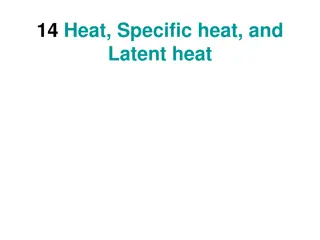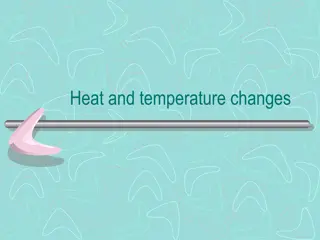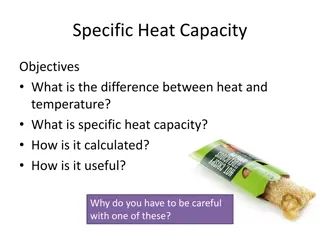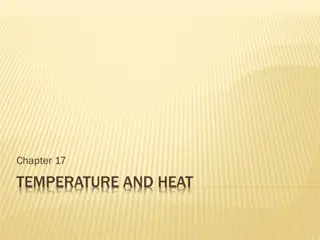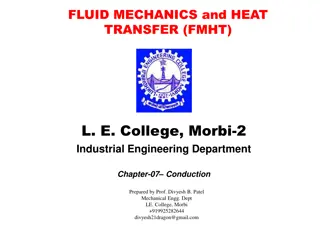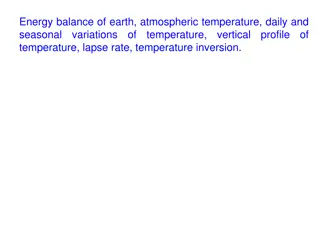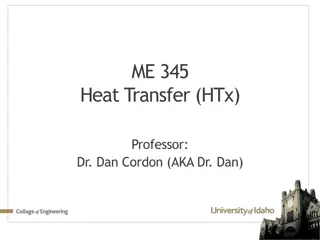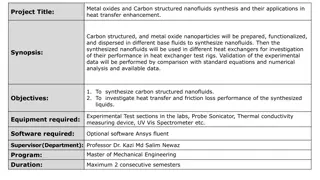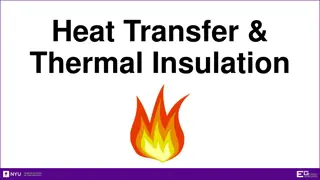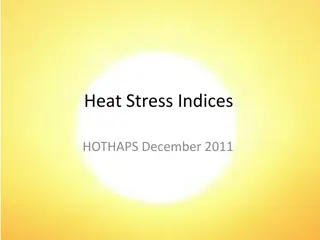Understanding Heat Transfer and Temperature Dynamics
Explore concepts of heat transfer, temperature changes, and thermal equilibrium through practical examples like wrapping a fur coat around a thermometer, holding a metal nail against ice, firewalking, and the greenhouse effect inside a car. Learn why differences in temperature, heat flow, and conductors play crucial roles in these phenomena.
Download Presentation

Please find below an Image/Link to download the presentation.
The content on the website is provided AS IS for your information and personal use only. It may not be sold, licensed, or shared on other websites without obtaining consent from the author. Download presentation by click this link. If you encounter any issues during the download, it is possible that the publisher has removed the file from their server.
E N D
Presentation Transcript
Heat Transfer March 20, 2007
Warm-up Wrap a fur coat around a thermometer. Will its temperature rise? Explain why or why not. If you hold one end of a metal nail against a piece of ice, the end in your hand soon becomes cold. Does cold flow from the ice to your hand? Explain.
Answer No, the thermometer will not heat up because it is the same temperature as the coat. There has to be a difference in temperature in order for heat transfer to take place No, cold does not flow. Heat flows from your hand to the nail to the ice. Since your hand is losing heat, it feels cold. HEAT is the only thing that flows.
Practice Question Explain why firewalkers can walk safely across a bed of red-hot coals in bare feet.
Answer Because the rate of heat transfer is slow, because coals are not very good conductors. If they walk fast enough, there is only a small amount of heat transferred to their feet, and they do not burn.
Practice Question If heat transfers from hot to cold, and stops when the two objects reach the same temperature, explain why it is possible for the inside of your car to be hotter than the air outside on a hot summer day.
Answer The greenhouse effect. Electromagnetic waves from the sun enter your car through the windows and are absorbed by the seats and other objects in the car. They then re- emit electromagnetic radiation of a different wavelength that cannot pass through glass. All of that energy is therefore trapped inside the car, causing the temperature to rise.
Practice Question Since a hot cup of tea cools more rapidly than a lukewarm cup of tea, would it be correct to say that a hot cup of tea will cool to room temperature before a lukewarm cup of tea will?
Answer No, because as it cools, the rate of heat transfer slows down until it is just as slow as the lukewarm cup of tea. The only way to make it cool faster is by introducing convection. (mpemba effect)
Practice Question The Concorde supersonic airplane is 20 cm longer when in flight. Explain why.
Answer As the jet flies, it experiences a huge amount of friction, which heats it up significantly. This causes thermal expansion, and the plane lengthens.
Practice Question What is temperature a measure of?
Answer The average kinetic energy of the particles.
Practice Problem If you drop a hot rock into a pail of water, the temperature of the rock and the water will change until both are equal. The rock will cool and the water will warm. Is this true if the rock is dropped into the Atlantic Ocean?
Answer Yes, yes, yes!!! Even though the Atlantic ocean is huge, the heat that leaves the rock enters the water (law of conservation of energy). This means that the temperature will increase. Since the ocean is a huge body of water, it will be an incredibly small change, but a change nonetheless.
Practice Problem When you step out of a swimming pool on a hot, dry day, you feel quite chilly. Why?
Practice problem The water will start evaporating in the air. Evaporation requires energy (heat) and that heat will come from your body. Since you are losing heat, you will feel cold.
Practice Problem Does a gas give off or absorb energy when it turns into a solid?
Answer: It gives off energy, because it is going from high energy to low energy.
Practice Problem Why does blowing over hot soup cool the soup?
Answer Convection cooling is a very effective method of heat transfer.
Practice Problem In a still room, smoke will sometimes rise only so far, never reaching the ceiling. Why?
Answer The smoke will be initially hot. Since hot air is less dense than cool air it will rise. However, it will cool as it rises until its density is the same as the density of the air in the room. At that point, it will stop rising.
Question If a cool cup of water is floated inside of a pot of water that is already boiling, will the water in the cup ever boil?
Answer NO! Heat will transfer from the boiling water to the cool water until the two are the same temperature. At that point, there will be no more net heat transfer. In order for the water in the cup to boil, it needs more heat after it reaches 100 degrees Celsius.



